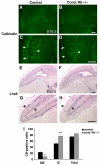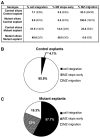A cell-autonomous requirement for the cell cycle regulatory protein, Rb, in neuronal migration
- PMID: 16308563
- PMCID: PMC1356328
- DOI: 10.1038/sj.emboj.7600887
A cell-autonomous requirement for the cell cycle regulatory protein, Rb, in neuronal migration
Abstract
Precise cell cycle regulation is critical for nervous system development. To assess the role of the cell cycle regulator, retinoblastoma (Rb) protein, in forebrain development, we studied mice with telencephalon-specific Rb deletions. We examined the role of Rb in neuronal specification and migration of diverse neuronal populations. Although layer specification occurred at the appropriate time in Rb mutants, migration of early-born cortical neurons was perturbed. Consistent with defects in radial migration, neuronal cell death in Rb mutants specifically affected Cajal-Retzius neurons. In the ventral telencephalon, although calbindin- and Lhx6-expressing cortical neurons were generated at embryonic day 12.5, their tangential migration into the neocortex was dramatically and specifically reduced in the mutant marginal zone. Cell transplantation assays revealed that defects in tangential migration arose owing to a cell-autonomous loss of Rb in migrating interneurons and not because of a defective cortical environment. These results revealed a cell-autonomous role for Rb in regulating the tangential migration of cortical interneurons. Taken together, we reveal a novel requirement for the cell cycle protein, Rb, in the regulation of neuronal migration.
Figures








References
-
- Anderson SA, Eisenstat DD, Shi L, Rubenstein JL (1997) Interneuron migration from basal forebrain to neocortex: dependence on Dlx genes. Science 278: 474–476 - PubMed
-
- Atwal JK, Massie B, Miller FD, Kaplan DR (2000) The TrkB-Shc site signals neuronal survival and local axon growth via MEK and P13-kinase. Neuron 27: 265–277 - PubMed
-
- Caviness VS Jr (1982) Early events of neocortical assembly: experimental studies and human pathology. Int J Neurol 16–17: 102–109 - PubMed
-
- Clarke AR, Maandag ER, van Roon M, van der Lugt NM, van der Valk M, Hooper ML, Berns A, te Riele H (1992) Requirement for a functional Rb-1 gene in murine development. Nature 359: 328–330 - PubMed
-
- DeDiego I, Smith-Fernandez A, Fairen A (1994) Cortical cells that migrate beyond area boundaries: characterization of an early neuronal population in the lower intermediate zone of prenatal rats. Eur J Neurosci 6: 983–997 - PubMed
Publication types
MeSH terms
Substances
LinkOut - more resources
Full Text Sources

